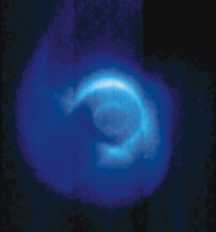







 |
 |
 |
 |
|||||
 |
 |
 |
||||||
 |
||||||||
 Plasma
enveloped
Plasma
enveloped
[At right: Cold, ultraviolet
plasma is colored blue in this photo of Earth. A hook-shaped “tail” of
plasma spirals out toward the Sun. The small, faint circle near the center
of the image shows the ultraviolet glow from the aurora, Earth’s northern
lights. NASA captured this false-color image of plasma — transparent, electrified
gas — trapped inside Earth’s magnetic field on Aug. 11, 2000. The spacecraft
IMAGE, Imager for Manetopause to Aurora Global Exploration, takes
the shots to provide a global view of Earth’s magnetic field and magnetic
storms. The spacecraft was looking down at Earth from above the North Pole,
and the globe or sphere in the center represents the position and size
of the Earth. The direction of the sun is beyond the upper right-hand corner.]
CR
Sun cycle spotty
in climate talks
The Intergovernmental Panel on Climate Change on Jan. 21 summed up
model simulations and observations over the last 140 years as best when
natural forcing factors are combined with human induced changes. And for
the last 50 years, the report shows that most of the observed warming is
attributable to human activities. Where does this put sun spots? The jury
is still out. “The warming over the last 50 years due to anthropogenic
greenhouse gases can be identified despite uncertainties in forcing due
to anthropogenic sulphate aerosol and natural factors (volcanoes and solar
irradiance),” the report says. In a graph comparing radiative forcing factors
on the climate system the IPCC rated the scientific level of understanding
on the Sun’s own influence “very low”. But as advances in regulating greenhouse
gases and aerosols occur over the next 50 years knowledge of how all forcings
interact will be critical, says James Hansen of NASA’s Goddard Space Program,
“including solar irradiance.”
CR
Chevron pipes ups
In a letter to the Foreign Ministry of Turkey on Feb. 8, Chevron Corp.
announced its interest in working as part of a sponsor group in the engineering
phase of developing a pipeline from the southern Caspian Sea to the Mediterranean
Sea. The pipeline, if built, would run from the Azerbaijan capital of Baku
through Tbilisi, the capital of Georgia, to the Turkish port of Ceyhan.
Although Chevron had not involved itself in the Baku-Ceyhan line before,
it supported the idea pushed by the American government. “After the Caspian
Pipeline, a new line through Turkey would be a logical next step to provide
market access to the anticipated large new reserves from both the east
and west sides of the Caspian,” said Richard H. Matzke, president of Chevron
Overseas Petroleum in 1998 during a speech at the Caspian Oil & Gas
Summit. The Caspian Pipeline, which runs from Tengiz, Kazakhstan to Novorossiysk,
Russia is planned for completion mid-year 2001, and will be capable of
transporting 600,000 barrels a day of crude oil. Currently railcars and
barges transport 260,000 barrels a day from the region, says Chevron spokeswoman
Jan Golon.
CR
 |
Geotimes Home | AGI Home | Information Services | Geoscience Education | Public Policy | Programs | Publications | Careers |